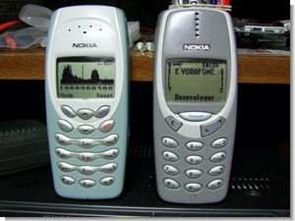
Cep telefonlarının lcd ekranları mikrodenetleyiciler ile sık sık kullanılıyor nokia 3410 lcd atmel atmega8 ve cywm6935 modül ile 2.4 ghz spectrum analyzer devresi yapılmış
Portatif 2,4 GHz Spektrum Analiz Cihazı
CYWM6935 modülü tabanlı 2.4 GHz ISM bant spektrum analizörleri ile ilgili bazı web sayfalarını ziyaret ettikten sonra, bazı iyileştirmelerle kendi analizörümü oluşturmaya çalıştım. İnternette bulduğum referanslar, bir ana bilgisayara paralel bağlantı noktası veya seri bağlantı kullanıyordu. Analizörün taşınabilir ve kolay taşınabilir olmasını istiyorum, bu yüzden bir mikrodenetleyici ve bir grafik LCD kullanacağım.
Ayrıca bazı eski Nokia telefonlarım da vardı, bu yüzden belki kendi taşınabilir analiz cihazımı yapmak için telefonun plastik kutusunu kullanabilir ve LCD’ye inşa edebilirim, ama… Yapılabilir mi? Görelim:
Mikrodenetleyici: Mikrodenetleyici, hem LCD modülü hem de CYWM6935 3,3 volt cihazlar olduğundan, 3,3 voltta çalışan bir ATMega8 olacaktır. ATMega8, düşük dahili saat hızlarında bile işini iyi yapacak, bu yüzden dahili osilatörü kullanarak 4 MHz’de çalıştırmayı seçiyorum.
LCD: LCD telefondan, bu durumda bir Nokia 3410 olacaktır. LCD bir PCD8544 kullanır, bu nedenle onunla çalışmak kolay olmalıdır. Bu tür LCD denetleyicileri kullanmak için etrafta pek çok kod var.
Pil: Bu telefonlar iki tür pil kullanabilir: Li-ion ve Ni-Mh, ancak ekipman açısından her iki tür de eşdeğerdir. Yararlı voltaj aralığı 4,2 ila 3,6 volt arasındadır. İlk fikrim 3.3 voltluk bir voltaj regülatörü kullanmaktı ama uygun bir tane bulamayınca pil ile devre arasına tek bir 1N4004 diyot koymayı seçtim. Yararlı aralık (4,2 şehir – 3,6 volt) eksi diyottaki 0,6 volt düşüş, devre beslemesinde 3,6 ila 3,0 volt olarak görülecektir. LCD ve CYWM6935 modülü 2,7 ila 3,6 volt arasında çalışabilir, bu nedenle her şeyin güvenli bir şekilde çalışması gerekir.
Prototip
İlk problemimi bulduğumda modül ve mikrodenetleyici fonksiyonlarını test etmek için bir prototip monte ettim. İnternetteki bilgilere göre Nokia 3410 LCD, Nokia 3310 LCD ile aynı PCD8544 denetleyicisini kullanıyor, bu nedenle her iki LCD de aynı sabit yazılımla çalıştırılabiliyor. Evet ve hayır. Her iki LCD de aynı PCD8544 talimat setini kullanır, ancak ekran çözünürlükleri farklıdır. Orijinal Nokia 3310 LCD 84 x 48 pikseldir, ancak Nokia’nın 3410 LCD’si 96 x 65 pikseldir, dolayısıyla yeni çözünürlüğü kullanmak için LCD rutinlerinin yeniden yazılması gerekir.
Rutinleri yeniden yazdıktan sonra çalışan bir LCD beklemelisiniz, değil mi? Tekrar olmasın. Nokia 3410 LCD’nin görünür çözünürlüğü 96 x 65 pikseldir, ancak LCD denetleyici içindeki gerçek çözünürlük 102 x 72 pikseldir, dolayısıyla kodunuzu yazarken bunu aklınızda bulundurmalısınız.
Solda: Nokia 3310 rutinlerine sahip Nokia 3410 LCD. Sağ: Doğru çözünürlük rutinlerine sahip Nokia 3410 LCD
İkinci sorun CYWM6935 modülüydü. Optimum performans için zamanlamalar ve doğru bir modül başlatma çok önemlidir, bu nedenle her şey yolunda olduğunda, test sinyalimle birlikte ilk 2,4 GHz spektrum ekranımı gördüm: 2468 MHz’de çalışan bir kablosuz kamera.
Birçok testten sonra, spektrumu ekranda göstermenin farklı yollarını buldum, biri hızlı dijital sinyalleri (wifi, bluetooth vb. gibi), biri analog sinyalleri (kablosuz kameralar, kablosuz telefonlar, vb.) tüm bandın ortalama kullanımı. Bu modlar arasında kolayca geçiş yapmak için bir çift düğmeye ihtiyacım olacak ve pillerle çalıştığım için ekran üstü bir voltmetre iyi olurdu. Bu, mikrodenetleyicinin ADC’si ile kolayca gerçekleştirilebilir, böylece taşınabilir 2,4 GHz spektrum analizörü için son şema tamamlanmıştır.
Bir Nokia 3410 kasası, bileşenleri monte etmek için çok fazla alana sahiptir, ancak önemli bir sınırlama vardır: Orijinal Nokia PCB’nin yüksekliği olan 3,3 milimetreden daha yükseğe çıkamazsınız, bu nedenle SMD bileşenleri bunu başarmanıza yardımcı olacaktır.
Bileşenlerimi 3,3 milimetrenin altında tutmak için, PDIP ATMega8 mikrodenetleyiciyi ve iki düğmeyi yerleştirmek için PCB’de delikler açmam gerekiyordu. Delikler yapıldıktan sonra, PCB’yi LCD plastik kasasıyla birbirine yapıştırdım, bu şekilde küçük LCD temas noktalarını tel ile pedlere lehimleyebildim.
CYWM6935 modülü 3,3 mm sınırının oldukça üzerindedir, ancak daha önce modülü iletim antenini çıkarmak için keserseniz telefonun anten yerine yerleştirilebilir: Kullanılmayacaktır.
Her bileşen yerine oturduğunda, ince yalıtımlı tel ile bağlantıları yaptım. Bu nihai sonuç, güzel değil ama tamamen işlevsel:
Bir sonraki adım altı vidayı yerleştirmekti, böylece analiz cihazı tamamlandı.
Yazılım, Windows (WinAVR) altında arv-gcc kullanılarak C dilinde yazılmıştır. LCD yordamları, Fandi Gunawan’ın Nokia 3310 yordamlarını temel alır ve CYWM6935 yordamları, Jason Hecker’in kodunu temel alır (ayrıntılar için alt kısma bakın). Program sürekli olarak çalışır ve saniyede yaklaşık altı veya yedi tarama (2400’den 2495 MHz’e kadar) yaparak verileri neredeyse gerçek zamanlı olarak görüntüler.
Uygulanan üç görüntüleme modu vardır:
Hızlı: Genlik verilerini işlemeden doğrudan modülden görüntüleyin. Bu mod, analog sinyalleri (taşıyıcılı) aramak için uygundur.
Yavaş: Güncelle
amplitüd verileri sadece mevcut sinyal bir öncekinden büyükse ekranda görüntülenir, değilse, görüntülenen sinyal sıfıra ulaşana kadar bir azaltılır. Bu mod, genellikle arka arkaya gelen dijital sinyalleri görmek için kullanışlıdır. Hızlı ve yavaş mod, bir iletişim alıcısındaki AGC ayarı gibi çalışır.
Pozlama: Bu modda, sadece mevcut değer bir öncekinden daha büyükse ekranda sinyal güncellenir. Bu şekilde, bu modu birkaç saniye veya dakika çalıştırarak, etrafınızdaki spektrum kullanımının güzel bir fotoğrafını çekebilirsiniz. Sıfırlama düğmesi, yeni bir pozlama başlatmak için ekranı temizler.
Uygulamada
Analiz cihazı benim en iyi yol arkadaşım oldu. Çok gizli: herkes sizin bir cep telefonuyla oynadığınızı düşünüyor!. Bulunduğunuz yerde kullanılan frekansların/kanalların ne olduğunu bir anda görebilirsiniz. En ilginç şeylerden biri, onu cepte teşhir modunda taşımak ve bir ara mahallenizde yürümek. Bu sayede ücretsiz frekansların veya kanalların neler olduğunu kolayca bulabilirsiniz. Zamanla, farklı cihazları nasıl ayırt edeceğimi öğrendim:
WI-FI sinyalleri: Pozlama modunda, en fazla 20-22 MHz genişliğinde hoş bir yuvarlak şekle sahiptirler.
Kablosuz FM kameralar (ve ATV sinyalleri): Taşıyıcıyı ve modülasyonu net bir şekilde görebilirsiniz. Video sinyalinde ses varsa, ana taşıyıcıdan yaklaşık 6 veya 7 MHz uzaklıkta bir çift yan bant görebilirsiniz.
Bluetooth cihazları: Bu cihazların, pozlama modu dışında algılanması zordur. 2483 MHz’e kadar tüm spektrumda rastgele tepe noktaları olarak görünürler.
Mikrodalga fırınlar: Sadece tam ölçekli gürültü. Merkez frekansının ocak yüküyle birlikte kaydığını fark ettim: Fırının içinde hiçbir şey yoksa, merkez birkaç MHz yukarı kayar. Genellikle, yaklaşık 60 veya daha fazla MHz’lik bir gürültü bant genişliğine sahip olan 2450 civarında ortalanırlar. Tabii ki kahvaltı, öğle ve akşam yemeklerinde ana sinyallerdir.
Diğer cihazlar: Bantta tanımlanamayan birçok başka sinyal var. Bazıları analog, diğerleri dijitaldir, ancak genellikle birkaç MHz genişliğindedir. Kablosuz klavyeler veya bu tür cihazlar gibi düşük oranlı cihazlar olduklarından şüpheleniyorum. Ayrıca çoğu 2440 MHz civarında olmak üzere güçlü taşıyıcılara sahip bazı yerler tespit ettim. Henüz ne olduklarını bilmiyorum.
Bant dışı sinyaller: ICM bandı 2483,5 MHz’de sona eriyor, ancak analizör 2495 MHz’e kadar tarama yapıyor. Bu bölümü genellikle bir gürültü referansı olarak kullanırım, ancak bazen bu alanda sinyaller bulmuştum. Bazıları ICM cihazlarından kaynaklanıyor gibi görünüyor, ancak diğerleri değil…
En çok kullanılan frekans her zaman 2450 – 2470 MHz segmenti, wifi kanalı 11’dir. Sanırım bu, birçok kablosuz yönlendirici ve erişim noktasında ortak varsayılan kanaldır.
İyileştirmeler
Buna ulaştıysanız, analizörde iki eksik şey olduğunu fark edeceksiniz. İlki bir açma / kapama anahtarıdır. Görünüme zarar vermeden bir anahtarı nereye kurabilirim? Başlangıçta telefonun üst kısmına yerleştirilmişti, ancak şimdi modülün bulunduğu yer burası ve kabloları anteninin yanına yerleştirmek iyi bir fikir değil. Ama bir açma/kapama düğmesini kaçırmadığımı itiraf etmeliyim. Analizör 15 mA’dan daha az tüketir, bu nedenle bu telefonların tipik 900 mAh piliyle birkaç gün kesintisiz çalışabilir.
İkinci eksik şey, yerleşik bir pil şarj cihazıdır. Küçük bir Li-ion pil şarj cihazı uygulamak güzel olurdu, ancak bu tür pillerin çok dikkatli bir şekilde şarj edilmesi gerekir. Küçük bir Li-ion entegre devre şarj cihazı bulsam, orijinal şarj jakını ve tabii ki orijinal telefon şarj cihazını kullanarak içine takmayı denerdim. Bu arada pilleri dışarıda, ortalıkta bulduğum yedek bir Nokia 3330’da şarj ediyorum.
Belgeler
After visiting some web pages about 2.4 GHz ISM band spectrum analyzers based on the CYWM6935 module, I tried to build my own analyzer, but with some improvements. The references I found on the net used the parallel port or a serial link to a host computer. I want the analyzer to be portable, and easy to transport, so I will use a microcontroller and a graphical LCD.
I had also some old Nokia phones, so maybe I can use phone plastic box and build in LCD to make my own portable analyzer, but… Does it can be done? Let’s see:
Microcontroller: The microcontroller would be an ATMega8 running at 3.3 volts because both the the LCD module and the CYWM6935 are 3.3 volts devices. The ATMega8 will do nicely the job even running with low internal clock rates, so I choose to run it at 4 MHz using the internal oscillator.
LCD: The LCD would be the one from the phone, in this case a Nokia 3410. The LCD uses a PCD8544, so it must be easy to work with it. There are many code around to use this kind of LCD controllers
Battery: This phones can use two kind of batteries: Li-ion and Ni-Mh, but both types are equivalent from the equipment’s point of view. Useful voltage range is 4.2 down to 3.6 volts. My first idea was to use a voltage regulator to 3.3 volts, but I didn´t find a suitable one, so I choose to put a single 1N4004 diode between the battery and the circuit. The useful range (4.2 town to 3.6 volts) minus the 0.6 volts drop out at the diode will be seen as 3.6 down to 3.0 volts at the circuit supply. The LCD and CYWM6935 module can work from 2.7 up to 3.6 volts, so everything must work safely.
The prototypeI mounted a prototype to test module and microntroller functions when I found my first problem. According to the info on Internet, Nokia’s 3410 LCD uses a PCD8544 controller, the same as the Nokia 3310 LCD, so both LCD can be driven with the same firmware. Yes and no. Both LCD use the same PCD8544 instructions set, but screen resolutions are different. Original Nokia 3310 LCD is 84 x 48 pixels, but Nokia’s 3410 LCD is 96 x 65 pixels, so LCD routines must be rewritten to use the new resolution.
After rewriting the routines, you must expect a working LCD, isn’t it? Not again. The Nokia 3410 LCD have a visible resolution of 96 x 65 pixels, but the real resolution inside the LCD controller is 102 x 72 pixels, so you must to have this in mind while writing your code.
Devrenin kod ve şema dosyaları : ea4eoz.ure.es/hsa.html
Şifre-Pass: 320volt.com
Yayım tarihi: 2010/03/24 Etiketler: ATmega8 devreleri, atmega8 uygulamaları, atmel avr projeleri, cywm6935, nokia lcd, spectrum analyzer devresi

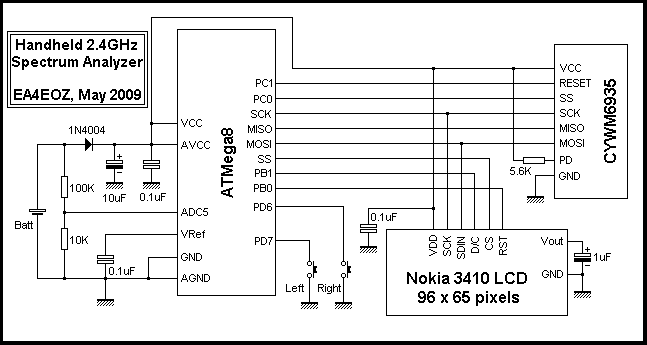
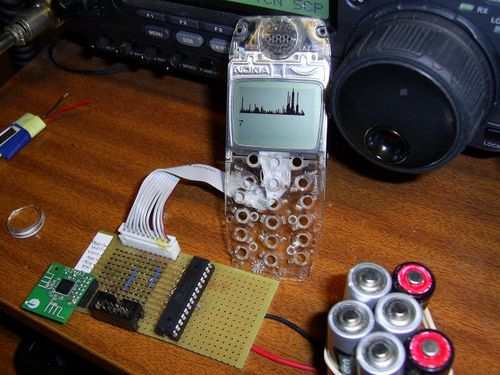
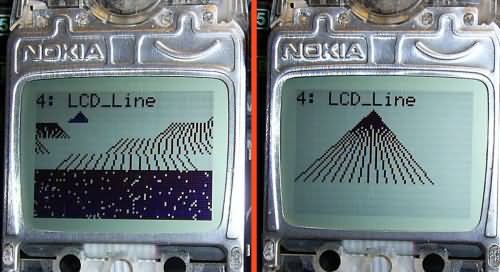
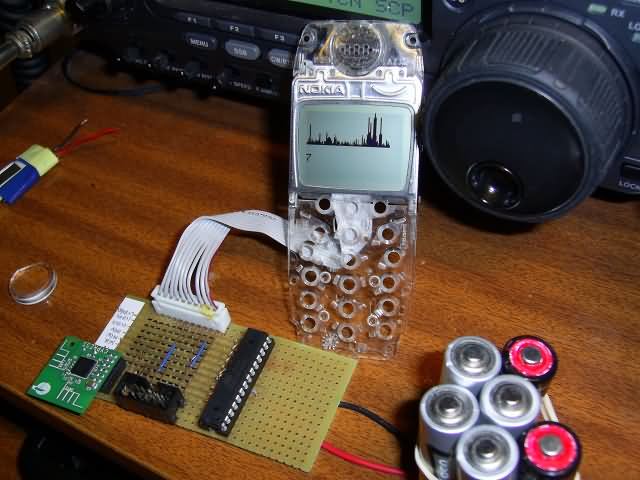
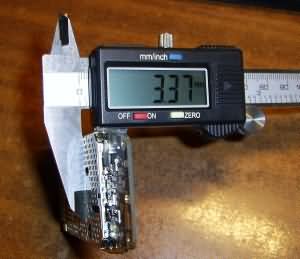
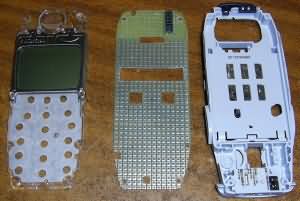
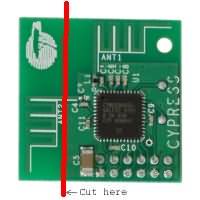
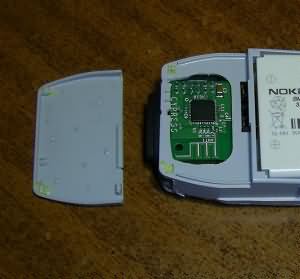
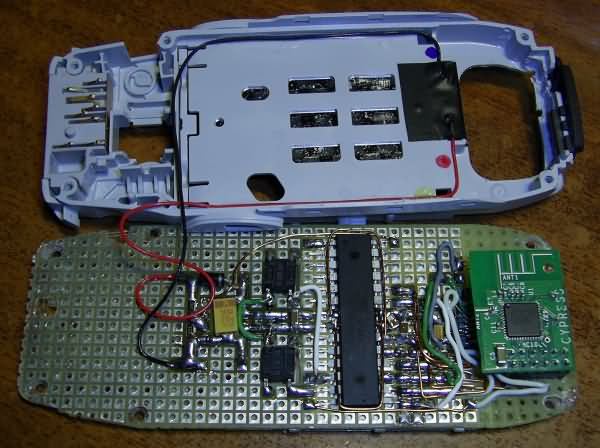
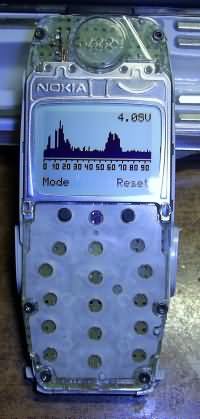
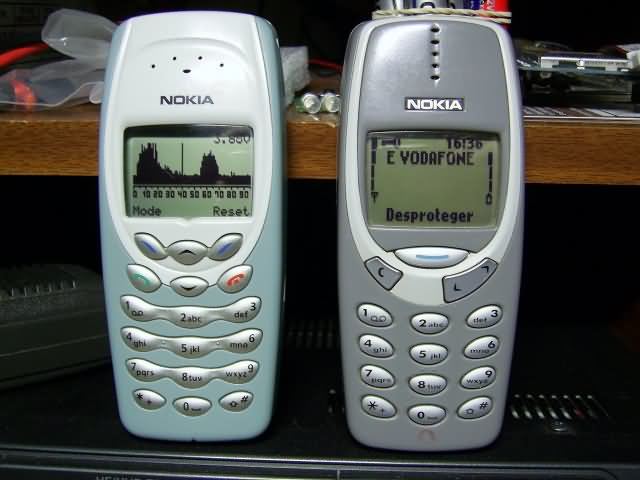
Daha Geniş bandlı spectrum analyzer hakkında bilgi sahibi olan varmı?